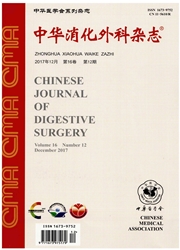

 中文摘要:
中文摘要:
目的探讨肝细胞癌(HCC)中脱嘌呤/脱嘧啶核酸内切酶(APE1)的表达特点及APE1与突变型053表达的关系。方法收集1991年至2004年第三军医大学大坪医院野战外科研究所病理科10例正常肝组织、40例结节性肝硬化组织和103例HCC组织标本,应用免疫组织化学SP二步法分别检测APE1和p53的表达情况。采用χ2检验、相关分析及KIndependent—SamplesTests检验分析所得结果。结果APE1在正常肝组织、肝硬化和HCC组织中均有不同程度的表达,阳性率分别为40.0%、82.5%、100.0%,三者比较差异有统计学意义(χ22=47.852,P〈0.01)。正常肝组织APE1仅表达于细胞核;肝硬化和HCC组织中APE1出现异位表达,异位表达率分别为20.0%和53.4%(χ2=20.757,P〈0.01)。不同APE1/p53表达模式的HCC临床分期及病理学分级比较差异有统计学意义(χ2=12.910,14.481,P〈0.01),APE1异位表达/p53阳性的HCC恶性程度高。结论APE1过表达及异位表达与HCC的发生、发展密切相关;APE1异位表达和p53突变可能在肿瘤的发生、发展过程中具有协同促进作用。
 英文摘要:
英文摘要:
Objective To detect the expression of apurinic/apyrimidinic endonuclease 1 (APE1) and explore its correlation with the expression of mutant 1953 in hepatoeellular carcinoma (HCC). Methods The expression of APE1 and mutant p53 was detected by SP immunohistochemieal method in 10 specimens of normal liver tissue, 40 specimens of liver cirrhosis tissue and 103 specimens of HCC tissue which were collected at the Department of Pathology of Duping Hospital from 1991 to 2004. All data were analyzed by ehi-square test, correlation analysis and K Independent-Samples Tests. Results The expression rate of APE1 in HCC was 100.0% , which was significantly higher than that in normal liver tissue (40.0%) and liver cirrhosis tissue (82.5%) (χ2 = 47. 852, P 〈 0.01 ). The expression of APE1 was only detected in the nucleus in normal liver tissue. Ectopie expression of APE1 in cytoplasm was detected in liver cirrhosis tissue and HCC tissue, with the rate of 20.0% and 53.4%, respectively (χ2 = 20. 757, P 〈 0.01 ). There was statistical difference in clinical staging and pathological grading of HCC with different comb/nations of APE1 expression (intranuclear or eetopic expression) and mutant p53 expression (positive or negative expression) (χ2 = 12. 910, 14. 481, P 〈 0.01 ), and HCC with eetopic expression of APE1 and positive expression of p53 had high malignant degree. Conclusion Overexpression and ectopic expression of APE1 in cytoplasm may play important roles in the genesis and progression of HCC, and the ectopie expression of APE1 and p53 mutation may have synergistic effect.
 同期刊论文项目
同期刊论文项目
 同项目期刊论文
同项目期刊论文
 期刊信息
期刊信息
